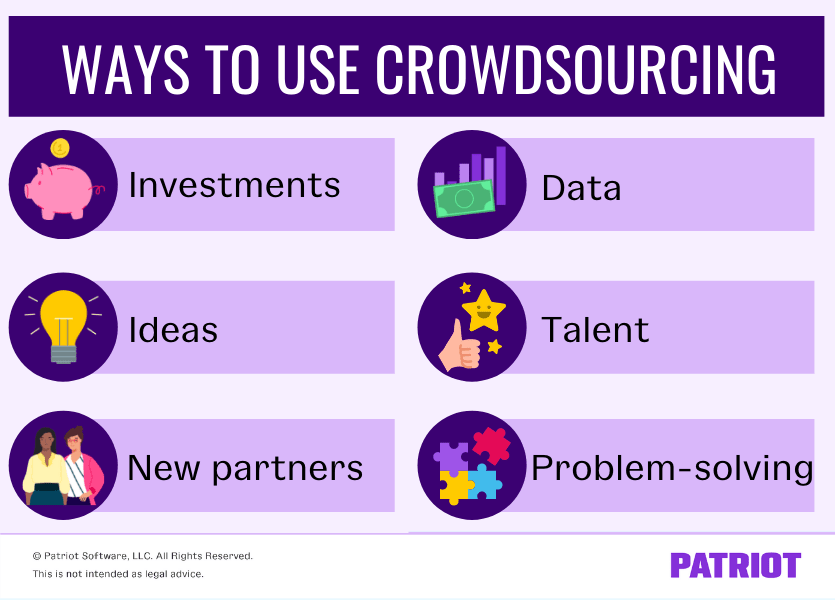Your business is your baby. You want to see it grow and prosper. But sometimes, you need to try new methods to get the word out about your company and raise funds for business growth. Thanks to the technological age, more options are out there now to assist you with funding and growing your business—like crowdsourcing. So, what is crowdsourcing?
What is crowdsourcing in business?
Crowdsourcing is the process of getting ideas, information, opinions, content, services, or funding from a group of people. With crowdsourcing, companies can tap into more expertise, skill sets, and funding by getting help from others. Think of crowdsourcing as a type of suggestion box for your business. You can use it to collect useful information from a specific group.
Crowdsourcing generally occurs online with members of different groups providing necessary resources and information. Some people are paid freelancers, while others work voluntarily. In some cases, crowdsourcing can even help you scope out suppliers, employees, or vendors.
Some crowdsourcing types can include innovation, crowdtesting, microtasking (i.e., split large jobs into smaller tasks), and crowdfunding.
Crowdsourcing for startups is popular among new entrepreneurs looking for assistance, advice, and funding. However, businesses big and small can use crowdsourcing to grow.
Crowdsourcing vs. crowdfunding
If you’ve heard of crowdfunding before, you may be wondering, “What is the difference between crowdsourcing and crowdfunding?” Good question…
Crowdfunding is a type of crowdsourcing. But, they’re not one and the same. Crowdfunding is when you raise capital through customers, family, friends, and investors on websites and platforms (e.g., GoFundMe). Like crowdsourcing, there are different types of crowdfunding, including donations, rewards, equity, and debt.
Both crowdsourcing and crowdfunding use technology and groups to reach a common goal, such as raising money for a business. However, while crowdfunding is strictly for raising funds, you can use crowdsourcing for a variety of reasons (e.g., information, services, etc.).
How to use crowdsourcing to grow your business
There are a number of ways to use online crowdsourcing to help your business. Here are just some of the ways:
- Investments
- Ideas
- New partners
- Data
- Talent
- Problem-solving
Investments
Crowdsource funding for small business is becoming a popular method to raise capital for things like:
- Business growth
- Special projects
- New products or services
- Starting a business
You can use crowdsourcing as an alternative financing option for your business. Instead of pitching to investors or applying for a business loan, you can tap into crowdsourcing to have others invest in your business for any reason.
Crowdsource funding allows you to get the money you need to start or grow your business. Depending on how you use it, you may decide to ask people for an investment or donation (and you don’t pay them back). Or, you may choose to just borrow money from contributors and promise to pay them back later.
Ideas
You can also use unpaid or paid crowdsourcing to gather ideas from customers, potential customers, or others.
You may use crowdsourcing to gather ideas about:
- New offerings
- Changes to current offerings
- Features
- Content
With this crowdsourcing method, you can ask others to give their feedback about your company and use those ideas to improve your business.
Depending on how you crowdsource, it’s a win-win—you get the feedback you need, and your customers get to feel heard about their opinions.
New partners
Crowdsourcing can also help you meet people who can be helpful for you and your business. And in some cases, you may get in touch with people you want to partner up with for the long-run.
For example, during the crowdsourcing process you may meet a supplier you want to work with. Or, you may meet another business owner you can team up and collaborate with.
Data
Many businesses use crowdsourcing as a way to gather data from consumers.
Businesses can use crowdsourcing to gather information about customer personas, including demographics, interests, and more. You can use this information to build your marketing strategy, tweak your market analysis findings, and connect with consumers.
You can also collect data from customers about your offerings, improvements, and features.
Talent
Although many people use crowdsourcing as a way to get insight, data, and ideas for a one-time project, some companies may decide to use crowdsourcing as a way to find talent and volunteers.
For example, say you use crowdsourcing to hire a coder for a special project. After the project is complete, you like their work so much that you decide to offer them a full-time position.
Some businesses may use crowdsourcing as a way to scope out top talent. You may bring someone onboard for a one-time task to see their capabilities and if they would be a good fit for your company.
Problem-solving
Businesses can use crowdsourcing to also solve problems and brainstorm ideas. You may reach out to an audience to find solutions to a problem and bounce ideas around if you’re stuck in a rut. Then, you can use those solutions to help improve your business and solve any issues.

Pros and cons of crowdsourcing
Before you start creating a crowdsourcing strategy, you have to know what you’re getting into. To get an idea if crowdsourcing is the right fit for your business, check out the pros and cons of it below.
Pros of crowdsourcing
Of course, the perks of crowdsourcing can vary depending on the type of crowdsourcing help you get. Crowdsourcing can potentially help you:
- Solve problems more quickly
- Save time and money
- Build up customer data
- Gain brand ambassadors
- Get more innovative and diverse ideas
- Fill knowledge gaps
- Accelerate certain processes
- Get feedback on virtually anything
As you can tell, there are plenty of advantages to using crowdsourcing in business. But, there are a few downsides…
Cons of crowdsourcing
Before you jump on board the crowdsourcing train, explore the disadvantages of crowdsourcing:
- Less control over the process
- Risk of inconsistency
- Internal conflict
- Issues with confidentiality being compromised
- Poor quality entries
- Potential for failure
Again, disadvantages can vary depending on the crowdsourcing business ideas you use.
Crowdsourcing examples
Are you a visual person who wants to see crowdsourcing in action? We get it. To help picture how crowdsourcing works, take a look at a couple of crowdsourcing examples below.
Example 1: Crowdsourcing a job or task
Some companies use crowdsourcing to get certain jobs or tasks done to avoid the expense and process of hiring an in-house employee.
Say your company needs to hire someone to design a new logo. However, you don’t want to hire a full-time employee to take on the one task.
To get help with the design of your new business logo, you use crowdsourcing by getting samples from multiple graphic designers for a small fee. Then, you pick a favorite out of the bunch and work with the designer you select.
By crowdsourcing a task, you can get a job done quickly. And, you can gain access to more innovative ideas by asking a group of people for help with the task.
Example 2: Crowdsourcing for funds
Again, many businesses use crowdsourcing to raise capital for their company—especially startups.
Let’s say you just started your venture and are looking for help with funding. You’re not quite ready to pitch to large investors or banks, but you’re in need of funds to help get the ball rolling on your business idea. So, you decide to use crowdsourcing to raise capital by engaging with people interested in your idea (e.g., family, friends, people on social media) and asking them to contribute by using a crowdfunding platform.
Tracking business expenses and income can be a pain. Patriot’s online accounting software takes the stress out of recording transactions and helps you save time and money for what matters most: your business. Get started saving with a 30-day free trial today!
This is not intended as legal advice; for more information, please click here.






